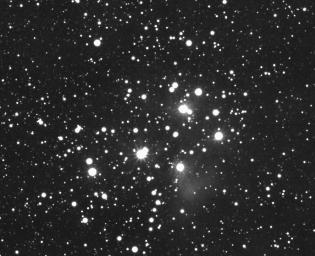Open clusters are clusters of stars that were formed together and are still near each other. The mutual gravity of the stars usually isn't enough to hold them together, so the stars in open clusters gradually drift away from each other as they follow their own path through the galaxy. For the several million years that they are near each other, they can make a beautiful sight in the sky here on Earth.
The stars start out near each other as a result of having formed out of the same cloud of dust and gas in the galaxy. These clouds are many light-years across, and anywhere from a few to a few hundred stars can form out of a single cloud (the numbers are usually from a few to a few dozen stars.) Once stars form they blow the leftover gas and dust away from themselves. Sometimes this causes new clumps in the cloud that form into more new stars. At some point the available gas and dust becomes too little for form new stars, and it gets thin enough that the stars can be seen from outside the cloud. The leftover gas and dust may surround the young stars for quite some time, adding to the beauty of the cluster.

Here is a recent NASA image of massive star formation going on in a remote galaxy. Over 4000 new stars per year--ten times what we get in the Milky Way!

The Seven Sisters, or The Pleiades, a star cluster that's easy to see with the naked eye in Taurus. You can see some of the left over gas and dust as nebulosity (cloudiness) in this image.



No comments:
Post a Comment